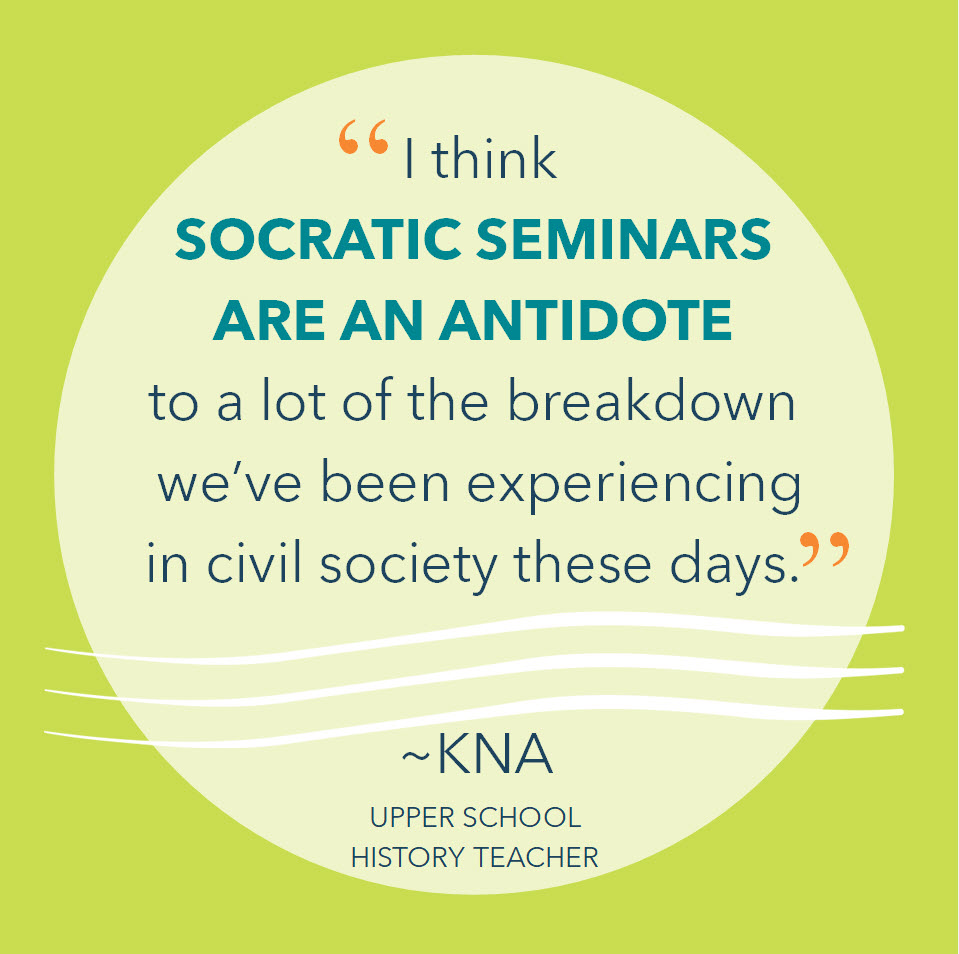Hyla Stories
Socratic Seminars in 9th Grade

by KNA (Karen Natorp Anderson), upper school history teacher.
A successful Socratic seminar is a thing of beauty – students sitting in a circle engaged in dialogue. There is so much going on in that moment: individuals asking discussion-worthy questions, a thread of ideas being carried and clarified by multiple people, participants calling attention to specific details to ponder and themes to examine, and a group of individuals working together to deepen their understanding. It is not a debate. It is not about winning points. A good discussion requires students to arrive prepared, stay engaged, and participate by listening closely and contributing their own thoughts and observations. To be honest, I think Socratic seminars are an antidote to a lot of the breakdown we’ve been experiencing in civil society these days.
As a pedagogical method, Socratic seminars fit well into the work 9th graders are doing in their “Global Studies” history class. Recently students examined what multiple historical sources reveal about how the world changed in 1492 when Christopher Columbus arrived in the Bahamas. We zoomed in on this watershed moment in world history as it is a familiar one – and there is much more to discover about the early decades of contact between Europeans and the Americas in the 16th century and its influence on the world we live in. Here are a few of the sources included in our examination:
- Queen Isabella’s Instructions for the New World (1501 primary source)
- Howard Zinn’s A Young People’s History of the United States
- Alfred Crosby’s The Columbian Exchange
- Mathew Restall’s Seven Myths of the Spanish Conquest
- Jared Diamond’s Guns, Germs, and Steel
- The Life Story of Malitzen
And here are some of the questions students raised during our Socratic seminar:
- How has living through a Covid-19 pandemic helped us understand the impact germs might have had on Hernan Cortes’s conquest of Tenochtitlan?
- Why do you think Queen Isabella’s 1501 Instructions for the New World (which called for fair treatment and wages of indigenous people and consent for marriage between indigenous women and European men) weren’t enforced or followed?
- Do you think Jared Diamond (Professor of Geography and author of Guns, Germs, and Steel) underestimated the power of cross-cultural communication barriers and cultural attitudes in his account of the Battle of Cajamarca?
- How much of a difference did the guns of the time make in these encounters?
- What do we make of Doña Marina/Malintzin’s role in history? Is it fair to consider her La Malinche, or ‘the traitor’ for her help translating and advising Hernan Cortes?
- How does the translation of accounts from different languages and different cultures impact our understanding of the past?
History Debates in the News: We aren’t the only ones debating and revisiting this moment in history! Here’s a quick NPR story discussing the Spanish Conquest of the Aztec Empire 500 years later.
Coming up next: Students will examine the origins of the African Diaspora before looking at the age of imperialism and resistance in Asia and Africa.

